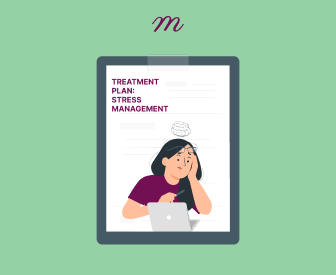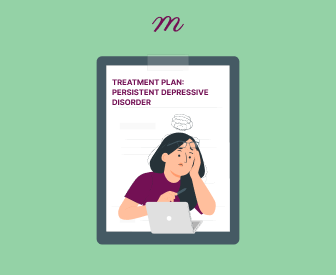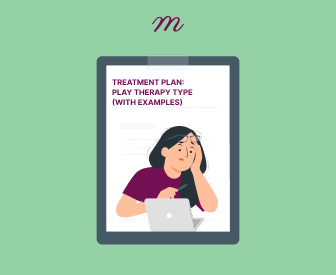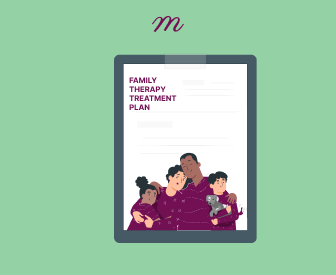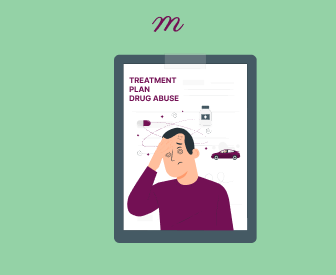Have your progress notes written for you automatically
Coping with stress is a routine problem for clients, it is therefore common for therapists to create structured stress management treatment plans. This article outlines the process of writing an effective stress management treatment plan, including key components, goals, objectives, and evidence-based strategies with practical examples.
What is a Stress Management Treatment Plan?
The treatment plan outlines the strategies, interventions, and measurable objectives designed to help clients cope with and reduce stress. A structured approach provides a roadmap for the client, ensuring progress is monitored and quantifiable goals are achieved over time.
Key Elements
A well-written treatment plan provides a structured framework that aligns with the client’s needs and offers clear direction for progress. Below is a detailed description of each section to ensure the plan is practical and actionable.
- Presenting Problem. This section outlines the client’s primary stress-related concerns and concisely describes their stressors and their impact on various aspects of life. Use client statements, observed behaviors, and assessments to clarify the presenting problem.
- Example: “The client reports experiencing chronic stress due to work-related deadlines, financial pressures, and family responsibilities. Symptoms include fatigue, insomnia, irritability, and frequent headaches. The client feels overwhelmed, stating that stress impairs personal and professional functioning.”
- Tip: Include context about environmental stressors (workplace, home) and internal stressors (unrealistic expectations, perfectionism, negative thought patterns). Also, mention any significant triggers or recent events that worsened the stress.
- Goals. This section lists the overarching outcomes the client wants to achieve. Goals should align with the client’s values and focus on areas where the client seeks relief or improvement. They should also focus on short- and long-term improvements in stress management and emotional regulation.
- Examples:
- Reduce the frequency and intensity of stress-related symptoms to improve quality of life.
- Improve the ability to manage unexpected stressors without becoming overwhelmed.
- Cultivate work-life balance by delegating tasks and creating time for self-care activities.
- Tip: Goals should remain broad but attainable and reflective of the client’s personal or professional aspirations.
- Objectives. These specific, measurable steps guide progress toward goal achievement.
- Examples:
- “Identify and challenge three negative thought patterns related to work performance within four sessions.”
- “Practice relaxation techniques (such as deep breathing) three times per week and report on their effectiveness after one month.”
- Tip: Break objectives into small, manageable tasks that the client can realistically integrate into daily routines. This ensures steady progress, which builds momentum.
- Interventions. Therapeutic tools and strategies support the client in managing stress. This section outlines evidence-based techniques developed for the client’s unique situation.
- Examples:
- Cognitive Behavioral Therapy (CBT): Help the client reframe distorted thinking patterns contributing to stress.
- Mindfulness Practices: Introduce mindfulness meditation to enhance emotional regulation.
- Progressive Muscle Relaxation: Train the client to relax muscle groups to reduce physical tension.
- Psychoeducation: Provide information on the body’s stress response and healthy coping strategies.
- Tip: Specify how each intervention will be applied in-session and between sessions. For instance, “The client will complete a thought journal to monitor triggers, which will be reviewed weekly during sessions.
- Timeline. Timelines provide realistic expectations for how long each step or goal will take. While timelines can be adjusted, having a plan promotes accountability and structure.
- Examples:
- Initial goal setting: Weeks 1-2
- Developing coping skills: Weeks 3-6
- Evaluating progress and adjusting techniques: Week 8
- Tip: Be transparent with clients about potential setbacks and emphasize flexibility. For example, “While relaxation techniques may be effective within a few weeks, cognitive restructuring may require 2-3 months for you to notice significant changes.”
- Evaluation. This section includes concrete benchmarks for success and defines how progress will be measured, clarifying whether the interventions are effective and goals are being met. Evaluation methods should be clearly outlined to track the client’s improvements over time. These include self-reports, behavioral observations, or physiological measures (e.g., improved sleep or lower heart rate). Regular progress reviews allow the therapist and client to adjust the plan if needed.
- Examples:
- Use a stress scale to track changes in perceived stress.
- Review self-reports to monitor improvements in physical symptoms (e.g., fewer headaches, better sleep).
- Assess the client’s ability to utilize coping techniques in real-life situations after 6 weeks.
- Tip: This process should include subjective measures (client feedback) and objective measures (behavioral observations or clinical assessments). Regularly scheduled reviews ensure the plan remains effective, allowing for adjustments as needed.
Writing a Stress Management Treatment Plan
- Presenting Problem
Lena, a 34-year-old professional, reports chronic stress related to her workload and struggles to balance her personal life and work projects. She experiences frequent jaw tension, reduced appetite, insomnia, and irritability, which negatively impact her relationships and job performance.
- Establish Goals
- Develop healthier responses to stressors.
- Reduce the frequency and intensity of stress-related symptoms.
- Improve sleep, appetite, and overall well-being.
- Enhance work-life balance.
- Increase emotional regulation skills.
- Set SMART Objectives
- Client will engage in relaxation exercises (e.g., deep breathing or progressive muscle relaxation) daily for the next 30 days.
- The client will journal daily about triggers and stress responses to identify patterns over the next four weeks.
- Client will reduce screen time after 8 PM to improve sleep within 6 weeks.
- Choose Evidence-Based Interventions
Cognitive Behavioral Therapy (CBT): The client will identify and reframe negative thought patterns that contribute to stress.
Mindfulness-Based Stress Reduction (MBSR): The client will use mindfulness techniques to manage stress in the present moment.
Progressive Muscle Relaxation (PMR): The client will tense and relax muscle groups to reduce physical tension.
Time Management Skills: The client will prioritize tasks to reduce overwhelming workloads.
Breathing Exercises: The client will use the 4-7-8 technique to promote relaxation.
- Create a Timeline
| Objective | Timeline |
| Practice relaxation exercises daily | 1 Month |
| Complete daily journaling practice | 4 Weeks |
| Implement time management strategies | 2-3 Months |
| Attend weekly therapy sessions | Ongoing (12 Sessions) |
- Evaluate Progress
- Progress will be evaluated every four sessions using self-report stress inventories and symptom logs.
- The client will complete the Perceived Stress Scale (PSS) every month to track changes in perceived stress levels.
- The therapist will review the client’s journal entries weekly to identify patterns in stress triggers and responses.
Sample Stress Management Treatment Plan
Client Name: Lena Johnson
Diagnosis: Adjustment Disorder with Anxiety (F43.22)
Date: xx/xx/xxxx
Presenting Problem: Lena reports experiencing chronic stress due to a high-pressure work environment. She feels overwhelmed by the demands of her job, leading to irritability, insomnia, muscle tension, and headaches. Sarah also struggles to set boundaries between work and personal time, contributing to burnout.
Goals
- Reduce work-related stress and improve emotional well-being.
- Develop healthy coping mechanisms to manage stress.
- Improve sleep quality and physical health.
Objectives
- Sarah will engage in 10 minutes of guided breathing exercises three times per week for the next 4 weeks.
- Sarah will practice progressive muscle relaxation (PMR) every night before bed for the next month.
- Sarah will identify three major stress triggers and discuss coping strategies with the therapist by the fourth session.
- Sarah will reduce her workload by delegating at least two tasks per week for 6 weeks.
- Sarah will track her stress responses in a journal daily to identify patterns over 30 days.
Interventions
- Cognitive Behavioral Therapy (CBT): Help Sarah reframe negative thoughts related to work stress.
- Mindfulness Exercises: Introduce mindfulness meditation to reduce reactivity.
- Progressive Muscle Relaxation: Teach Sarah to use PMR to manage physical tension at night.
- Time Management Coaching: Develop strategies to help Sarah prioritize tasks and set boundaries at work.
- Sleep Hygiene Education: Guide Sarah on creating a relaxing bedtime routine, including reducing screen time.
Timeline
| Objective | Timeline |
| Breathing exercises 3x/week | 1 Month |
| PMR before bed | 1 Month |
| Identify three stress triggers | 4 Sessions |
| Reduce workload through delegation | 6 Weeks |
| Journal about stress patterns daily | 30 Days |
Evaluation
- Sarah’s progress will be assessed using self-reports and the Perceived Stress Scale (PSS) every four sessions.
- Sarah’s sleep quality will be monitored using a sleep journal and weekly feedback.
- The therapist will review journal entries to track patterns in stress responses and coping strategies.
Suggestions for Writing an Outstanding Stress Management Treatment Plan
- Collaborate. Involve clients in goal-setting to increase their commitment and ensure the plan is practical and aligns with their needs and circumstances. Use motivational interviewing techniques to encourage clients to clarify their priorities.
- During intake sessions, explore the client’s values and ask open-ended questions to understand what success means to them.
- Example: “What would your ideal work-life balance look like?” or “What changes would help you feel more in control of your stress?”
- Joint goal-setting reinforces the idea that therapy is a partnership. When the client helps define objectives, they are more likely to stay motivated and feel empowered.
- Check realism and feasibility by gently refining overly ambitious goals into smaller, actionable steps. For example, if the client says, “I want to eliminate stress entirely,” you might reframe this as “Let’s aim to build coping skills that make stress more manageable.”
- Use Positive Language. Framing the treatment plan in positive language increases hope and motivation. Rather than focusing on behaviors the client needs to avoid, highlight what they will gain or achieve. Revisit goals throughout treatment to celebrate small victories, reinforcing positive language.
- Instead of writing, “The client will stop feeling overwhelmed by work,” reframe it as “The client will develop strategies to manage work stress more effectively.”
- Focus on desired outcomes, such as “The client will experience improved sleep hygiene,” rather than emphasizing negative symptoms.
- Words like "develop," "enhance," "achieve," or "improve" signal progress, which helps clients feel that change is possible and within reach.
- Remain Flexible. Clients progress at different rates, and life circumstances may change throughout the course of therapy. A flexible plan allows for adjustments based on the client’s evolving needs and experiences. Incorporate feedback loops into the plan—ask the client at each session what strategies worked well and what didn’t, making real-time adjustments.
- Let the client know that adjustments to the plan are expected, and the focus will be on what works best for them.
- Schedule a plan review after the first four sessions to assess progress and determine if any changes are needed.
- Discuss alternatives with the client if a chosen intervention isn’t ineffective. For instance, if mindfulness isn’t resonating, suggest progressive muscle relaxation or journaling.
- Monitor Progress. Regular monitoring is essential to ensure the treatment plan remains effective and that the client continues making progress. This process keeps the client accountable and motivated while providing valuable data for the therapist. If progress stalls, revisit the objectives and interventions to ensure they are still relevant. Collaborate with the client to reframe or adjust strategies that may be causing frustration.
- Review progress every 4-6 sessions, using measurable metrics such as stress scales or symptom tracking.
- Encourage clients to journal or use stress-tracking apps to record their experiences and progress between sessions.
- Celebrate minor improvements with the client, as positive reinforcement helps maintain engagement.
- Individualize the Plan. No two clients experience stress the same way, so the treatment plan should reflect the client’s unique personality, lifestyle, values, and coping preferences. Personalized plans are more likely to be effective and sustainable because they align with the client’s strengths. Use the client’s strengths to inform the plan. For example, if they are already good at problem-solving, focus on developing emotional regulation strategies.
- During initial sessions, explore what interventions resonate with the client. For example, some clients may prefer physical activities like yoga or exercise, while others may respond better to journaling or guided imagery.
- Choose strategies based on the client’s circumstances. For instance, a stay-at-home parent may benefit from techniques they can use during small breaks, while a busy professional may need quick, on-the-go stress relief tools.
- When recommending interventions, consider the client’s cultural background and personal values to ensure they feel comfortable and supported.
Conclusion
A well-written stress management treatment plan is essential for helping clients reduce stress and develop healthier coping skills. By breaking the process into manageable goals, objectives, and interventions, therapists empower clients to take control of their reactions to stress and improve their well-being. Remember to collaborate with clients, use evidence-based strategies, and regularly monitor progress to ensure the plan remains relevant and practical. Effective treatment planning allows clients to develop the tools necessary to manage stress and increase resilience.
References
Maruish, M. (2019). Essentials of Treatment Planning, Second Edition. John Wiley & Sons. Sperry, L. (2016). Behavioral Health: Integrating Individual and Family Interventions in the Treatment of Medical Conditions. Routledge Press.


